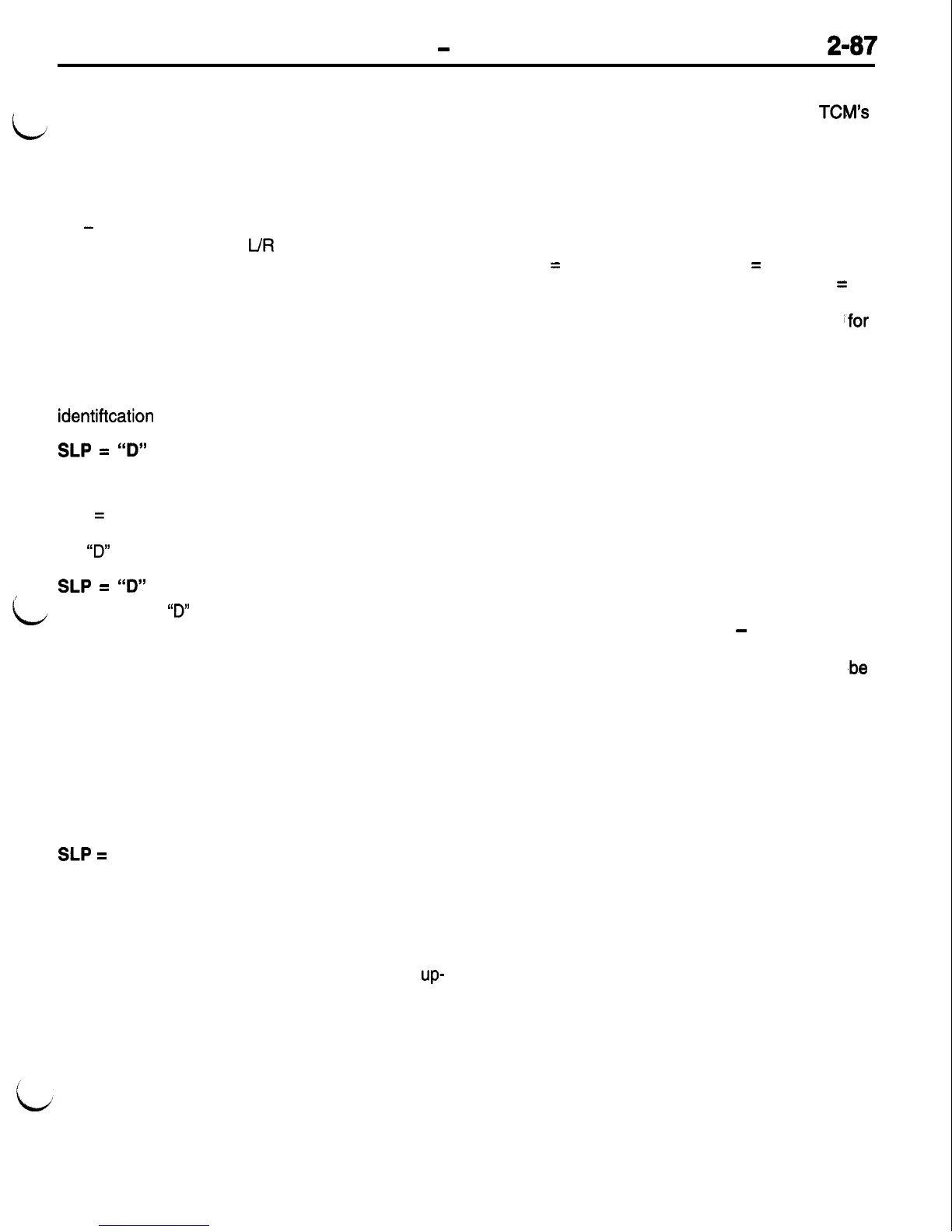POWER TRAIN
-
Automatic Transaxle
L
Inhibits and Shift Action Summary
For neutral (N) and reverse (R) there are no logic
inhibits placed on SLP changes into or out of either
neutral or reverse. These gear ranges are shift lever
controlled modes of operation. Neutral and reverse
must be immediately provided for. Also, a reverse
block function is used at speeds over approximately
10
-
15 mph by continuously venting the Low/Re-
verse (L/R) clutch. The
L/R
clutch is also vented
at speeds over 8 mph in neutral.
For drive (D), Second (2) or low (L), when speed
ratio or pressure switch errors occur during transaxle
use, the TCM will maintain the current gear range
to prevent potentially hazardous gear selection.
A separate set of shift schedules exist for each
engine/transaxle application. The TCM knows which
set of shift schedules to use by looking at the PCM
identiftcation
over the CCD bus. The engine and
SLP
=
“D”
Cold, Warm or Hot
The “D” schedule provides first, second, third and
fourth gears. This shift schedule is selected when
SLP
=
“D” and the transaxle calculated temperature
range is cold, warm or hot. It should be noted that
the
“D”
schedule will delay the 3-4 upshift, and will
body identifications are retained in the
TCM’s
memory to ensure that the correct schedule is used
if the CCD bus fails.
There are four different shift schedules within each
engine set. They are selected primarily by the Shift
Lever Position input code and the transaxle operat-
ing temperature range that is calculated. Separate
shift schedules exist for the following; Shift Lever
Position
=
D, Shift Lever Position
=
D (supercold
temperature range), and Shift Lever Position
=
L.
A typical set of shift schedules have been plotted
out in graph form. These have been modified
‘for
clarity. The shift schedules primarily use throttle
angle and output shaft speed as the determining
factors. The main difference between these sched-
ules are as follows:
cause earlier 4-3 downshifts when the transaxle
temperature range is cold. Throttle input is also
limited to prevent high engine speeds with a cold
engine.
SLP
=
“D”
(Supercold and Extreme Temperature Range)
I
L
The supercold
“D”
schedule is a revised D schedule.
It is selected whenever the initial calculated trans-
axle temperature is less than 0 degrees F. This
revised schedule prevents closely spaced shifts and
part throttle kickdowns. This results in delayed (high-
er speed) upshifts, earlier closed throttle downshifts,
and in most cases the inability to obtain either 4-2
or 3-1 kickdowns. The primary reason is to allow
more time for clutch pressures to achieve their nor-
mal in-gear condition after a shift. This should hap-
pen before the next shift occurs to avoid clutch
overlap (two clutches applied at the same time).
If the calculated transaxle temperature at start-up
is in the extreme cold range of
-
15 degrees F.
or less, all the solenoids will be held off. Also, the
pressure switch and speed sensor checks will
,be
disabled. This action provides the same mode of
operation as with limp-in or default (second gear
operation only, in any forward gear range selection).
This is done to prevent clutch damage and inadver-
tent shutdowns by delaying all TCM operation until
supercold conditions can be met.
SLP
=
L
The L schedule also has 1-2 and 2-3 shifts but
they are much more delayed. The determining factor
for this schedule is that engine speed is monitored
and shifts occur at peak engine RPM. Even though
the driver has selected the low position, the shift
schedule is designed to upshift the transaxle at
up-
per level engine RPM to protect the engine from
over-speed. Downshifts also occur at higher vehicle
speeds. This is done to provide the highest gear
ratio for maximum engine braking when descending
steep grades.

